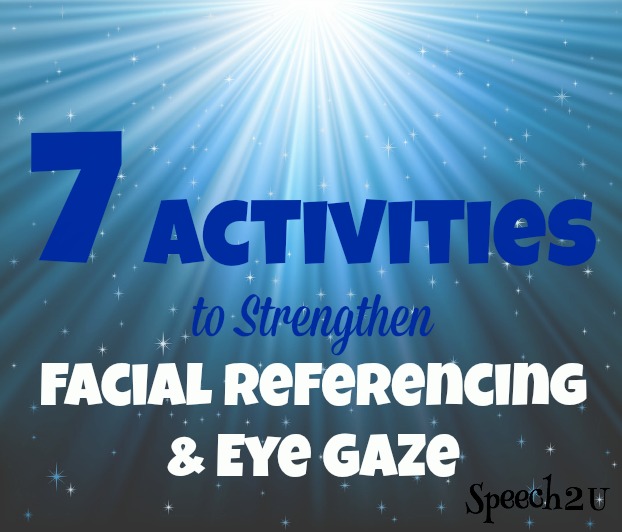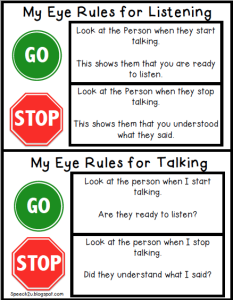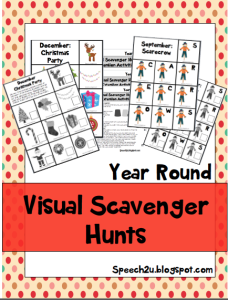- Big clear head shakes maybe by mouthing yes/no
- Subtle head nods
- Work on eyes or facial expressions-look mad/irritated if the answer is no, excited or hopeful if the answer is yes.
- Eyes only-try to communicate yes/no with only your eyes.
- Treasure or Easter egg hunts: (They have to check in with you to see if they are going the right way)
- Races: You let them know when it’s time to GO by your expression.
- Ball toss games: (No throwing unless I say “yes” with my eyes)
- Matching games or games like Cranium Cariboo (The child checks to see if they should open that box.)
Go/Stop Eye Rules for Listening and Talking
I cue them to use a START/STOP approach with their eyes on the listener or speaker.
We try to START our verbal communication by using visually checking in with the speaker. If they need to look away while they are speaking, they are able to do that in order to compose their thoughts. When they are done with their thought-they need to visually check in again. We talk about how we need to make sure that the person understood us so we look at their face and decide if we need to reword what we said. In general this has worked pretty well. My clients are able to check in to make sure the listener is ready to receive their message and then again at the end to see if the listener has understood the message. We talk about making judgments or inferences to decide how the other person feels about what we said. Sometimes, we need to work on how long they should talk-conversations are not monologues.
We use the same START/STOP approach when we are listening. We try to check in visually when we first hear someone talking to us to let the speaker now we are listening. We use “whole body listening” strategies for them to know we are still paying attention. We check in again when they are done speaking to let them know that we understood them. You can download your copy of GO/STOP rules by clicking the above picture.
Eye Tag:
This is a verbal cue that I use with some of my clients. We talk about eye contact and facial referencing. Then I cue for facial referencing by stating: Can you tag me with your eyes to ______. I am trying to give them information about why as a listener or a speaker I may want to get information from them. For example, “Can you tag me with your eyes to let me know that you are ready to start this activity?” or “You can tag me with your eyes to let me know that you are ready to start the game.”
Visual Scavenger Hunts
I love visual scavenger hunts-so I created a simple year round product to use with my clients. It will be on sale through April 11, 2015.
Autism Games is a blog that was run by Tahirih Bushey. It isn’t being updated anymore but it is worth some serious blog stalking if you work with children on the Autism Spectrum. What are your favorite activities for facial referencing?





Thanks for this great blog! I expect these ideas will become staples in my “SLP bag.” Can’t wait to share them with my colleagues and try them with my students.
Thanks! I’m glad you liked it!
Fabulous ideas, as always! Thank you!
Great idea! I am going to try this with several of my students. Can’t wait to share your ideas with my colleagues in our next content team meeting. I will share your blog site too. We are always looking for new ideas/activities to try in therapy. One of the best things about where I work is that there are about 20 therapists so somebody always has a new idea or solution to a problem.
Thanks so much! I bet it is great to have so many people to collaborate with.